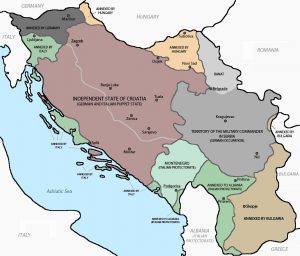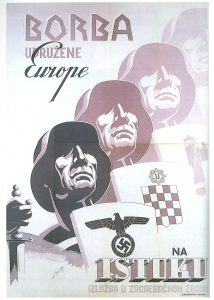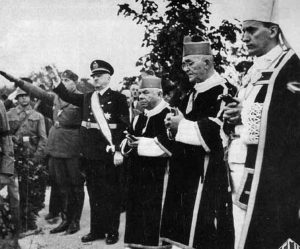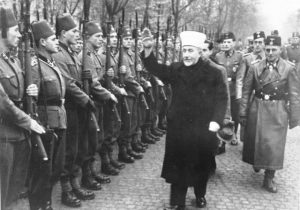A southern Slavic state emerges
In 1918, emerging from the collapse of Austria-Hungary, a constitutional monarchy was formed called the Kingdom of Serbs, Croats and Slovenes (SHS), which encompassed large parts of the Balkans. Right from the beginning, individual parties were skeptical about the centralism of the new state. Central actors for an independent Croatian state were the "Croatian Peasant Party" ("Hrvatska seljačka stranka", short: HSS), as well as the nationalist "Croatian Party of Law" ("Hrvatska stranka prava", short: HSP), from which later the Ustaša emerged. The Croatian Peasant Party, which became the third largest force in the 1920 Yugoslav elections, refused any parliamentary work until 1924 and was in fundamental opposition to the SHS.
The HSP becomes the Ustaša
Already in 1915, the later "Poglavnik" ("leader") of the Ustaša movement, Ante Pavelić becomes party secretary of the HSP, which was founded in 1861. The HSP rejected any form of Yugoslav state and called for a nationalistic Greater Croatia. Together with the HSS they formed the Croatian-nationalist opposition of Yugoslavia. However, this cooperation only lasted until 1924, when the Peasant Party made a declaration of loyalty to the Yugoslav state or rather to the Kingdom of the Serbs, Croats and Slovenes and participated in the government and in parliamentary work. Thus the Peasant Party gave up its refusal of the centralized state and demanded henceforth more autonomy within the state (see Hory / Broszat 1967).
When the internal Yugoslav tensions reached a climax in 1928, the leader of the Croatian Peasant Party Stjepan Radić and two other members of parliament were shot inside the parliament and King Alexander I. established a royal dictatorship following these events, the Peasant Party again went into strict opposition. Under these circumstances, the HSP thought the time ripe for a fascist overthrow attempt and began to expand its activism to militant actions. Armed groups were formed, which immediately began to carry out anti-Serb attacks. However, the HSP soon realized that there would be no Croatian-national revolution, partly because the Peasant Party under its new leadership was unwilling to support the activities of the HSP. With the proclamation of the Kingdom of Yugoslavia and the consequent prohibition of all parties in 1929, the "Ustaša Hrvatska Revolucionarna Organizacija" ("Croatian Revolutionary Organization of Insurgents"), short: Ustaša was founded. Pavelić and his confidants went abroad to establish contacts with Croatians in exile and politically related organizations and began to build up paramilitary units. There were two training camps in fascist Italy, which supported the Ustaša, and another in Hungary. In the following years, there were attacks and insurrection attempts, as well as lively propaganda activity outside and within Yugoslavia (see Hory / Broszat 1967).
As a result of the fatal assassination of the Yugoslav King Alexander I. in 1934, which was attributed to the Ustaša, fascist Italy reduced its support until it completely ended in 1937 due to a treaty of friendship between Italy and Yugoslavia: the training camps were dissolved, the leadership of the Ustaša placed under police surveillance and their members imprisoned. Supporters and structures of the Ustaša were also to be found in the Third Reich, but there was no such open support as from Italy, mainly due to diplomatic reasons. This severely restricted the activity of the Ustaša from 1937-41 (see Hory / Broszat 1967).
The founding of the Independent State of Croatia (NDH)
In 1941, due to heavy pressure from Nazi Germany, the Kingdom of Yugoslavia joined the Axis Powers (Germany, Italy, Japan), abandoning its policy of neutrality. As reaction, there was a coup in Yugoslavia, which was directed against the common policy with the Axis Powers and wanted to restore the previous policy of neutrality. Ten days later, on April 6th, 1941, the Nazi invasion of Yugoslavia began in response to the coup. On April 10th, the "Independent State of Croatia" ("Nezavisna Država Hrvatska", short: NDH) was proclaimed and since Vladko Maček (HSS) already refused to act as leader of the state before its founding, this role was taken on by Pavelić after he returned to Zagreb from exile on April 15th (see Calic 2010).
With the proclamation of the NDH a state emerged which covered parts of the territory of today's Croatia as well as Bosnia and Herzegovina. In addition to a Croatian-administered area, there was a German and an Italian military zone. In fact, this meant that the NDH was a vassal state of fascist Italy and National Socialist Germany, but could control a large part of its territory and act freely. With the seizure of power, an attempt was made to restructure society based on the model of National Socialist Germany. For example, the Nuremberg Race Laws were adopted on April 17th, 1941 with the introduction of the "Law for the Protection of the People and the State" (Calic 2010). There were also immediate anti-Serb and anti-Semitic measures and actions. A special feature of the NDH was, in contrast to other allies of Germany, the independent administration of a concentration camp system, which was operated without German help. In the largest concentration camp Jasenovac 80,000-90,000 Serbs, Jews, Roma_Romnij and political opponents were murdered (see Radonić 2004).
In addition to the NDH army and the Croatian police, the Ustaša also maintained regular and irregular militias. Like the National Socialists, the Ustaša also had an "elite unit" under their command - the 1st regiment of the Ustaša militia, the "Crna Legija" (Black Legion). Known for numerous massacres, this regiment is still worshiped on the Loibach Field / Libuško polje (see Korb 2013). In the summer of 1941, the Ustaša murdered more than 100,000 Serbs in mass shootings and expelled another 200,000 to Serbia (see Korb 2010). Soon the Ustaša militia used the same techniques as the German task forces did against the civilian population of the conquered Soviet Union: gathering of prisoners, letting them dig pits, mass shooting into the pits (see Korb 2013).
Ideological similarities between National Socialism and the Ustaša movement are revealed most prominently in that they share extermination anti-Semitism as their base as well as the reference to the ideology of the as Aryan defined ethnic group. The main difference between the two is the clerical, Catholic line of attack of the Ustaša. At the same time, Italian fascism was also an important reference point for the Ustaša. The Ustaša ideology can best be described as the "synthesis of national socialism and fascism with adaptation to the Croatian conditions" (Radonić 2004).
Catholic Croatia and the Ustaša
A major point of conflict for the SHS and later for the Kingdom of Yugoslavia was religion from the very beginning, precisely because it was considered an indication of national affiliation. 5.5 million inhabitants (about 46%) were Orthodox, 4.7 million (about 39%) Roman Catholic and 1.3 million (about 11%) Muslim (see Deschner 1982). There were also smaller Protestant and Jewish communities. Especially between the two largest religious branches there were power conflicts that were nationally charged. Serbia, together with Macedonia and Montenegro, was predominantly orthodox, Slovenia and Croatia catholic. The respective church played a major role in the corresponding national identification and the question of how power was distributed in the relatively young state. In addition, catholic Croatia was a strategically important place against Orthodoxy as well as Islam in the Balkans for the seat of the Roman Catholic Church, the Vatican. The completion of a concordat, a state church treaty between the Catholic Church and the Yugoslav State, worsened the dispute at the end of the 1930s. Both Serbian-national and Croatian-national movements never felt their interests to be sufficiently represented (see Deschner 1982). The Catholic Church obtained special rights in the NDH state, not least because of its importance for the seizure of power and the enforcement of the Ustaša regime. So it is not surprising that the proclamation of the NDH began with "God's Providence and the will of our great ally" and with "God be with the Croats! Ready for the Fatherland!" ended (see Hory 1965). At the same time the Orthodox Church was deprived of all rights. For Serbs this meant that they either had to convert by coercion, were deported and / or murdered. On May 3rd, 1941, there was already a "legal ordinance on the change of religion" which also specified who could convert at all. Orthodox priests, wealthy individuals and intellectuals should therefore only be allowed to convert in exceptional cases (see Dedijer 2011).
The assets such as the possessions of the Serbian Orthodox Church and of wealthy Orthodox individuals were often times transferred to the Roman Catholic Church. Furthermore all Jews were expropriated - one of the first steps towards the planned extermination. In addition, they had to wear a Star of David, Serbs a blue armband with a "P" for "Pravoslavac" (Orthodox person). Orthodox persons, as well as Jews, were denied access to many public places, such as sidewalks, offices, shops, restaurants, public transport and life in many parts of Zagreb (see Deschner 2012). Also, many of them were dismissed from their jobs and arrested, the Cyrillic scripture banned (see Dedijer 2011). Orthodox churches became Catholic or transformed into department stores, slaughterhouses, public toilets, stables, prisons, execution sites or completely destroyed. If Serbian children were still very small and without parents - for example, through murder or deportation of their parents - they were partly taken in by the Croatian Caritas to re-educate them (see Deschner 2012). While many Orthodox priests were murdered, the first officials of the Ustaša were often Catholic priests "appointed as senior field camp commandants, camp leaders and district and state superintendents" (Dedijer 2011). This was, amongst other things, due to the fact that they had previously been in noticeable and distinguished opposition to Yugoslavia. Especially the Franciscan Order and its monks were in important positions in the system of the Ustaša. Their monasteries served as weapons depots or organizing and training centers for the Ustaša. Members of the order acted as political advisors, civil governors and executioners in concentration camps. After the war, Franciscan monasteries in Austria, Italy and France took in fleeing Ustaša and Nazis (see Deschner 1982).
The 13th Waffen Mountain Division of the SS "Handschar"
In March 1943, the formation of the "1st Croatian SS Volunteer Division", later called "13th Waffen Mountain Division of the SS", began. Recruitment took place within the NDH state, especially in areas with a Bosnian majority population. Within a very short time 12,000 soldiers were registered, who were trained in the Bavarian Mittenwald and in southern France. The unit, which was sworn to both Adolf Hitler and Ante Pavelić, received German and Austrian officers and ultimately had about 25,000 soldiers. The unit consisted mainly of Bosnian and Herzegovinian Muslims and between a quarter and a third (non-Muslim) Croats (see Korb, Pavlowitch 177). The "Handschar" wore both symbols of National Socialist Germany and the coat of arms of the NDH state and were given instead of field chaplains Muslim field imams (from Zagreb) for their care. This unit was the first practical attempt to harness the common thread of anti-Semitism between Islam and National Socialism. The soldiers of the "Handschar" received ideological training on these questions, and the field imams also carried out anti-Semitic agitation.
The "Handschar" was involved in numerous operations of the NDH state from 1943 to 1945. The more threatening the situation became for the NDH state, the more soldiers deserted: partly to come to their villages, partly to defect to the partisans - sometimes whole groups of hundreds with their equipment. In the autumn of 1944, the situation became so acute that the officers recommended a disarmament of the unit - which reinforced the desertions. At the end of 1944, a large part of the unit was actually discharged. While the German and Austrian members of the unit fled to Austria via Hungary, numerous Bosnian and Croatian members found themselves in May 1945 in Bleiburg / Pliberk.
The end of the NDH state
With the advance of the Yugoslav People's Liberation Army and the looming surrender of the German Wehrmacht, Ustaša associations, Croatian Home Guard (Domobrani), sympathizers, high-ranking Ustaša officials, Chetniks, German Wehrmacht and (Waffen-) SS troops, etc. began to flee from the advancing Partisans towards the British-liberated zone. They hoped to surrender there in order not to fall into Yugoslav imprisonment, knowing full well about their crimes and the accompanying fear of retaliation. The Yugoslav People's Liberation Army wanted to prevent this by any means, they tried to cut off the escape route. Therefore strong military conflicts were common still until May 25th, 1945. Some units reached the Loibach Field / Libuško Polje near Bleiburg / Pliberk on May 14th, where they contacted British troops to surrender. However, the British troops refused the surrender in their territory and the units had to surrender to the Yugoslav People's Liberation Army who brought the soldiers, who had surrendered, to Yugoslav territory. On the way back, there were revenge actions, which killed tens of thousands. From these events, the Bleiburg victim myth was constructed. Contrary to the myth, shootings never happened in Bleiburg / Pliberk, these took place on Yugoslav territory. Bleiburg / Pliberk itself also does not represent THE unconditional surrender of the Ustaša, but is rather one surrender among several that took place in these areas (see Dietrich 2008).
Several thousand (including high-ranking and important) Ustaša officials were able to escape into exile with their relatives, where they made contact with sympathizing Croatian exile groups and from where they could continue their propagandistic and organizational activities. Pavelić himself fled via the Catholic "ratline" to Argentina. There he was under the protection of the dictator Peron and founded an exile government. Later he was forced to flee to Spain due to an assassination attempt, where he once again stood under protection, this time Franco’s, and died in 1959 (see Dietrich 2008 and Deschner 1965).
From socialist Yugoslavia …
After the end of the Second World War and the coming to power of the Communist Party of Yugoslavia, the "Federal People's Republic of Yugoslavia" was founded. Remembrance policy and culture was practiced and established according to "Fraternity and Unity" ("Bratvo i jedinstvo"), one of the central ideas of socialist Yugoslavia. The fight and struggle of the Partisans as a founding myth of Yugoslavia created the conditions for this: All blame was put onto the defeated non-communist enemies, any discussion concerning perpetrators, victims and resistance fighters was prohibited. The only admissible memory was the memory of the anti-fascist struggle, which banished items such as non-Yugoslav nationalism, perpetrators and fascism from the public sphere and thus the debate. Through this a kind of national harmony should have been established. This repression of and disassociation with the past and (reactionary) ideologies should, or could, not work long: Starting in the 1960s / 1970s, nationalist efforts and intentions could be heard more often.
In the 1960s, there was an increase in debates among Serbian and Croatian historians about the respective national participation in the partisan movement. Above all Franjo Tuđman, later to become the first President of the Republic of Croatia, occupied a central position in this debate (see Radonić, 2008). As a result of the nationalist debates, new victim myths emerged in the 1980s. Instead of accounting for and coming to terms with the past, a nationalist "remembering" took place. Here, too, Tuđman had a central role: In his 1989 published book “Horrors of War: Historical Reality and Philosophy” he summarized his view of history: He systematically downplayed the numbers of those murdered in the concentration camp Jasenovac and contrasted them with the same number of, allegedly in Bleiburg / Pliberk, murdered people by the Partisans. At the same time, he consistently spoke of Jasenovac as a "labor camp" claiming that Jews were themselves responsible for their extermination and postulated anti-Semitism as a constant of history. He did not deny the Ustaša crimes, but systematically offset them against crimes committed by Chetniks and partisans in order to downplay them (see Radonić 2008).
… to present-day Croatia
In April 1990 Franjo Tuđman and the "Croatian Democratic Community" (Hrvatska demokratska zajednica, short: HDZ), which was founded by him, won the first free elections in Croatia. After the independence of Croatia in June 1991, Tuđman, who ruled in a nationalist-authoritarian manner until his death in 1999, continuously referenced the NDH state positively: places were renamed after Ustaša officials, partisan monuments removed, the currency again called Kuna (as it was in the NDH) (see Calic 2010 and Radonić 2008). Although the HDZ today portrays itself as a pro-European, conservative party, the positive reference to the NDH remains an major part of Croatian society and HDZ policy.
References
Calic, Marie-Janine (2010). Geschichte Jugoslawiens im 20. Jahrhundert. München.
Dedijer, Vladimir (2011). Jasenovac das jugoslawische Auschwitz und der Vatikan. Freiburg.
Deschner, Karl-Heinz (1965). Mit Gott und den Faschisten. Der Vatikan im Bunde mit Mussolini, Franco, Hitler und Pavelić. Stuttgart.
Deschner, Karlheinz (2012). Mit Gott und den Faschisten. Der Vatikan im Bunde mit Mussolini, Franco, Hitler und Pavelić. Freiburg.
Deschner, Karlheinz (1982). Ein Jahrhundert Heilsgeschichte. Die Politik der Päpste im Zeitalter der Weltkriege. Von Pius XII. 1939 bis zu Johannes Paul I. 1978. Köln.
Dietrich, Stefan (2008). Der Bleiburger Opfermythos. In: Zeitgeschichte. 35. Jg. Heft 5. S. 298-317.
Hory, Ladislaus und Broszat, Martin (1965). Der kroatische Ustascha-Staat 1941–1945. München
Hory, Ladislaus und Broszat, Martin (2010). Der kroatische Ustascha-Staat 1941-45. München.
Korb Alexander (2010). The Germans and the Ustaša-massacrers. Syrmia 1942. In: Pattingson, Juliett and Shepherd, Ben (eds), War in a Twilight World. Partisan and Anti-partisan warfare in Eastern Europe, 1939-1945, Basingstoke.
Korb Alexander (2013). Im Schatten des Weltkriegs. Massengewalt der Ustaša gegen Sereben, Juden und Roma in Kroatien 1941-1945. Hamburg.
Radonić, Ljiljana (2008). Vergangenheitspolitik in Kroatien – Vom Geschichtsrevisionismus zur Aufarbeitung der Vergangenheit? In: Zeitgeschichte. 35. Jg. Heft 5. S. 282-297.




